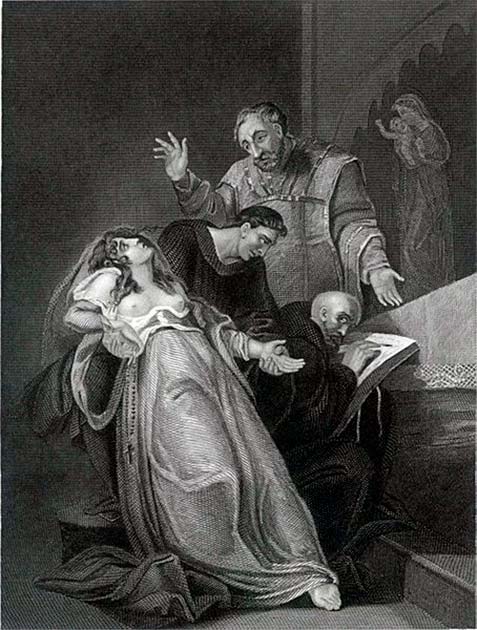Elizabeth Baron is perhaps not a familiar name to many, and even Catholic historians might be forgiven for overlooking her. Also known as the “Nun of Kent”, her fearless actions in the face of extreme personal danger are a testament to her beliefs.
Bu then, as with a lot about her faceted story, there are aspects which beg a different interpretation. Was she an eccentric, or did she suffer from some genuine malady? Was she a fraud, or manipulated by others?
What we do remember of her is her series of public prophecies relating to religion and other domains. During her lifetime, her preaching and her visions gained her a number of devotees, believers in her mystical prophecies.
She would experience death-like trances during which she would showcase supernatural abilities. She has made predictions relating to many aspects of Catholicism, including the Ten Commandments, the seven deadly sins, and the nature of heaven and hell.
But her moment of infamy came when she spoke out against the King of England, Henry VIII.
What do we Know of Elizabeth Barton?
Elizabeth Barton was an English Catholic nun who was born in the year 1506. Her early life is shrouded in mystery: we know she was illiterate and so can be sure she had no formal education during her early life.
At the age of 19, Barton was working as a domestic servant when she started to experience a mysterious illness. During the period of sickness, she would demonstrate unnatural abilities.
Elizabeth Barton made a number of predictions which, according to the witnesses, came to be true. A prediction that catapulted her to fame was the prediction of the death of a child who was being nursed in her household.

A special commission was established by the then Archbishop William Warham to question her. The commission ultimately concluded that the trances, prophecies and visions that Barton was having were genuine.
In no time, she was considered to be a star, and she gained thousands of followers who believed in her words. During the height of her popularity, she held an audience with King Henry VIII, Sir Thomas More and Cardinal Thomas Wolsey, and her popularity almost rivalled that of the king.
- Joan of Arc: Divinely Inspired or Mentally Ill?
- Prankster or Assassin? How Richard Roose Made Henry VIII Change the Law
However, her fame and notoriety were short-lived as her visions took an ominous turn, and Henry VIII became her enemy. Whatever else Elizabeth Barton was, she was unafraid to stand up to authority.
To give her bravery some context, Henry VIII spend much of his later life destroying the monasteries of England as he separated himself from the Catholic church. Frustrated by the Pope at his attempts to secure a divorce, he created his own Church of England and amassing the wealth of the religious houses into the crown as he did so.
Far higher-born people than Elizabeth Barton would fall and be killed as Henry did away with all dissenting voices. Modern estimates put the number of executions ordered by King Henry at close to 57,000, including his closest friends and two of his own wives.
The Nun of Kent was playing a very dangerous game.
A Martyr or a Pawn?
Many believe that Elizabeth Barton was manipulated by the people who wanted to see the downfall of King Henry VIII. She was believed to be the mouthpiece of people who could not stand the power that Henry had gathered to himself.
It is thought that, given the politically damaging nature of her sermons, that Barton may well have been influenced to speak against the king. It has been claimed that the nun was influenced by a man named Edward Bocking to speak out against the religious reformers of the era.
Bocking is believed to be her chief instigator who contributed to her journey of deception. Her outspoken criticism of Henry’s break with Catholicism saw her examined by Henry’s top agents: Thomas Cranmer, architect of Henry’s religious reformation, and Thomas Cromwell, Henry’s trusted right hand man.
They were likely not kind in their interrogation, skeptical of the visions she claimed supported her religious position. Through one way or another, she made the confession to Cromwell and his agents that she had been faking her prophecies and visions all her life. This confession was enough to see Barton as a political pawn who had been using her vision against King Henry.

So she was either an ill nun who was cruelly abused by Henry’s men and forced to sign a false confession, or a fraudster who sought to save her own skin when she realized she was in extremely hot water. However Henry was playing a dangerous game, too.
Catholicism was firmly entrenched in the lives of the lower classes during the early part of Henry’s reign, from the monasteries and churches which dotted the landscape to the Sunday sermons which for centuries had offered religious guidance to the poor. Henry’s destruction of the religious framework of England, from Thomas Wolsey on down, shook his subjects to their core.
Elizabeth Barton was extremely popular with the commoners, who may well have shared her sentiments and who loved a miracle in any case. Barton was stirring up trouble for the king, highlighting a problem of his own making.
- Nonsuch Palace: What Happened to Henry VIII’s Lost Castle?
- Centuries to Read: Maria Crocifissa’s Letter From the Devil
It is not entirely known whether Barton was manipulated and exploited as a mouthpiece in the political realm or not. But she succeeded in leaving her mark not just in the Christian world but in the history of the Church of England.
It is believed that Henry VIII himself was fearful of the powers of the nun as well as the prophecies that she had made against him. While some believe that Barton was manipulated due to which she made ominous prophecies relating to King Henry, others have the view that she may be the victim of the society where medical conditions such as epilepsy were not entirely understood.
What Happened to Her?
Elizabeth Barton’s downfall was partially of her own making. A series of events took place, due to which the popularity of Barton faded, and soon the love of the commoners was replaced with contempt and hatred.
It all began when Elizabeth Barton made the fatal mistake of preaching against King Henry’s marriage annulment to Catherine of Aragon. The event took place in the year 1532, and there was no looking back for the Nun of Kent.
She made the prophecy that if the king remarried Anne Boleyn, he would die within a few months, and his kingdom would crumble. She even claimed to have seen a piece of hell that was destined for the king.

These harsh words did not go down well with the king, and she was seen as a threat that had to be eliminated. Rumors about her sexual misconduct were fabricated and put about, which led to the downfall of her reputation. Based on the accusations, she was arrested.
In the last few weeks, Barton repeated her confession that she had been deceiving people. Her confessions were made in major towns in England. King Henry VIII had the fear in his mind that the visions and prophecies of Elizabeth Barton had the potential to lead to public rebellion against his rule.
In April 1534, with Henry still in rude health, Barton was found guilty, and she, along with a few others, was dragged through the streets before her later executed. Her execution is considered to be a warning sign for people who tried to oppose King Henry VIII.
Barton gained attention due to the religious visions. The prophecies and visions that she had helped her to achieve fame in no time. While some people still view Elizabeth Barton as a saint, there are people who consider her to be a charlatan.
Nevertheless, it is impossible to ignore the role that she played and the popularity that she gained within a short span of time due to her prophecies and visions. Although Barton met her tragic fate for taking a stand against the King, her courage is lauded by many as she was fearless in presenting her views and did not think of the consequences that could arise because of her ominous visions concerning Henry VIII.
Top Image: Did Elizabeth Barton speak out due to her own beliefs or someone else’s? Source: James Sant / Public Domain.
By Bipin Dimri